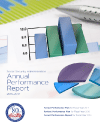- Home
- Agencies
- Department of Agriculture
- Department of Housing and Urban Development
- General Services Administration
- Department of Commerce
- Department of the Interior
- National Aeronautics and Space Administration
- Department of Defense
- Department of Justice
- National Science Foundation
- Department of Education
- Department of Labor
- Office of Personnel Management
- Department of Energy
- Department of State
- Small Business Administration
- Environmental Protection Agency
- Department of Transportation
- Social Security Administration
- Department of Health and Human Services
- Department of the Treasury
- U.S. Agency for International Development
- Department of Homeland Security
- Department of Veterans Affairs
- Goals
- Initiatives
- Programs
Primary tabs
Key to Changes
This text is Revised text
This word has been added to the text
This text is Last Published text
This word has been removed from the text
Modifed styling with no visual changes
FY 16-17: Agency Priority Goal
Reduce the Disability Hearings Pending
Priority Goal
Goal Overview
More than one million people are waiting for a hearing decision from an Administrative Law Judge (ALJ) on their requests for disability benefits. Many of those cases are pending because the Office of Disability Adjudication and Review (ODAR) does not currently have the resources in place to complete them in a timely manner. Pending requests for hearings have risen for three consecutive years due to recession-related filings and our inability to hire sufficient ALJs. Resolving this public service crisis is one of the Social Security Administration's highest priorities.
Although we constantly explore process efficiencies to improve our capacity and performance, only ALJs can hear and decide cases. We expect that with increased ALJ and support staff hiring in ODAR, we will begin reducing the pending requests for hearings before the end of calendar year 2016. Our first priority area in reducing the pending is focusing on completing our oldest pending cases first and we must do so without sacrificing the quality of our hearing decisions.
Historically our Aged Case Initiatives have proved highly effective in reducing our pending and eliminating our oldest cases first. Clearing our aged cases is vitally important to the Agency, to the Acting Commissioner, and most importantly, to the American people. It is both a business imperative and a moral imperative to serve these members of the public who have waited the longest by providing timely, quality disability hearing decisions.
Strategies
We have a four-pronged approach to reducing the hearing pending;
1. Increase Adjudicatory Capacity
- Continue to hire administrative law judges (ALJ) to ensure that we can provide the service our claimants expect and to continue reducing the pending
-
Leverage senior attorneys in the National Adjudication Team to increase adjudicatory capacity by screening for cases that can be allowed as fully-favorable without the need for a hearing
2. Process and Decisional Quality Improvements
- Pilot using pre-hearing conferences held by senior attorneys to gather evidence earlier in the process and decrease the number of cases postponed and unnecessarily delayed
- Assign one national lead for the national Aged Case Initiative to coordinate aged case processing with designated regional aged case coordinators
- Monitor case quality through structured random inline quality review of case files prepared for hearing and decision drafts awaiting ALJ review to ensure that the laws, regulations, and policies of SSA are applied equally and fairly to each individual claimant
-
Perform randomly selected pre-effectuation reviews of unappealed favorable decisions in order to have statistically significant data to monitor changes in regional and national decisional quality
3. Increased Accountability and Focus on Aged Cases
- Nationally track 'Aged Cases of Concern' and notify individual regions and hearings operation workload components regarding cases that are not being processed timely in accordance with the Chief Judge's Benchmarks for Quality Case Processing
- Provide internal ODAR recognition for offices that accomplish 99% of aged cases by August or 100% of aged cases by September
-
Utilize national workload support units to assist local offices with longer wait times
4. Leveraging Technology Improvements
- Transfer aged cases from offices with longer wait times to be heard by video in offices with greater capacity to hear cases
-
Monitor and track cases using existing workload and management information reports
Progress Update
We substantially met our target by completing 98.04% of our aged cases in FY 2016. During the fourth quarter, we completed 37,333 aged cases which brought us to a total of 256, 465 aged cases completed and within less than one percentage point of our goal. We heard more than 99% of our aged cases in FY 2016.
We exceeded our target to hire 250 ALJs and were able to hire 264 ALJs in FY 2016. 113 of those hires occurred at the end of the fourth quarter in FY 2016. It will take approximately ten months for them to orient to the hearings and disability process before they can become fully productive. Due to budget constraints and hiring freeze in FY 2016, we were not able to hire sufficient support staff to support the work of the additional ALJs. We must make up the lost hires in FY 2017 or we may lose ground in our efforts to reduce the wait times for hearings.
We conducted 39,460 video hearings during the fourth quarter of FY 2016 for a total of 151,162 Video Hearings in FY 2016. This fell short of the secondary indicator target of 170,000 video hearings.
During the fourth quarter, the Appeals Council agreement rate for ALJ decisions rose from 88.4% to 88.8% showing an improvement in quality. We continue other efforts to improve staff efficiency. We are providing electronic folder access for medical and vocational expert contractors to eliminate staff time needed to produce CD copies of case folders. We are improving this process and inviting more expert contractors to join our electronic folder access pilot before a national rollout.
FY 2016 Quarterly Milestones
Q4 -All aged cases pending in workload assistance units for writing are completed and returned to hearing office ALJ for signing.
We achieved 98.04% of this target. We experienced uneven attrition and inability to backfill losses in hearing offices and in particular, we had low levels of decision writers needed to complete writing of cases. Those offices turned to regional (RCAC) and national case assistance (NCAC) centers for writing assistance and sent their cases up to the last day of the year. This did now allow for sufficient time for the RCACs and NCACs to complete all writing and return to the ALJs for signing.
Q4 - Complete hiring of 250 ALJs and accompanying support staff.
We exceeded our goal and hired 264 ALJs with 113 of those hires occurring at the end of the fourth quarter. However, because of the FY 2016 hiring freeze, we were not able to hire sufficient support staff for our new judges.
Q3 - All aged cases pending in workload assistance units for writing completed and returned to hearing office ALJ for signing.
Given that we began the fiscal year with such a huge amount of aged cases, we were unable to meet this milestone. As of COB 06/30/16, 1,447 cases were pending writing assistance outside of their local office. The workload assistance units, as well as all offices, continue to give priority to writing decisions on the aged cases.
Q2 - All pending aged cases scheduled for hearing, except for cases where claimant actions caused a case to revert to an earlier case status.
Hearing offices were unable to schedule 14,936 cases as of March 25, 2016.
Q1 - Completion of case work-up and file assembly for all pending aged cases.
Hearing offices were unable to complete work-up and file assembly for 3,025 cases out of our universe of more than 260,000 Aged Cases. However, we are working aggressively to get this workload completed, and to meet the second quarter milestone.
Next Steps
We worked with our Analytics Center of Excellence (ACE) to conduct analysis and estimates of Aged Cases- Hearings Pending dispositions for FY 2017. This analysis forecasts:
| Aged Case Cutoff | Number of Aged Cases Pending | Project Completion Rate with attrition | Projected Completion Rate with no attrition |
| 430 | 403,000 | 81% | 87% |
This supports our plan to adjust our Primary target to decide 90% of cases that begin fiscal year at 430 days or older in FY 2017. We will reflect the updated FY2017 target with the Q1 FY 2107 progress update.
FY 2017 Quarterly Milestones
Q1 - Completion of case work-up and file assembly for all pending aged cases.
Q2 - All pending aged cases scheduled for hearing, except for cases where claimant actions caused a case to revert to an earlier case status.
Q3 - All aged cases pending in workload assistance units for writing completed and returned to hearing office ALJ for editing and signature.
Q4 - 99% of all aged cases closed.
Q4 - Complete hiring of an additional 250 ALJs and accompanying support staff.
Expand All
Performance Indicators
Aged Cases Reduction
Other Indicators
Administrative Law Judge Hires
Hearings held via video
Cases pending
Contributing Programs & Other Factors
The main risks that could prevent us from achieving our priority goal include not having sufficient numbers of Administrative Law Judges (ALJ) or supporting staff to decide the necessary number of cases, extremely constrained funding in FY 2016 and/or FY2017, and increasing declinations of video hearings.
Our assumptions and risks include:
- ALJ hiring and staffing levels
- Hearing operation support staff levels
- ALJ and support staff productivity
- Declination of video hearings causing an inability to hold sufficient hearings by video at our hearing offices with the longest wait times for a hearing
- Receipts
- Success of senior attorney screening efforts
- Success of the pre-hearing conference pilot
- Constrained FY16 and FY17 funding
No Data Available











